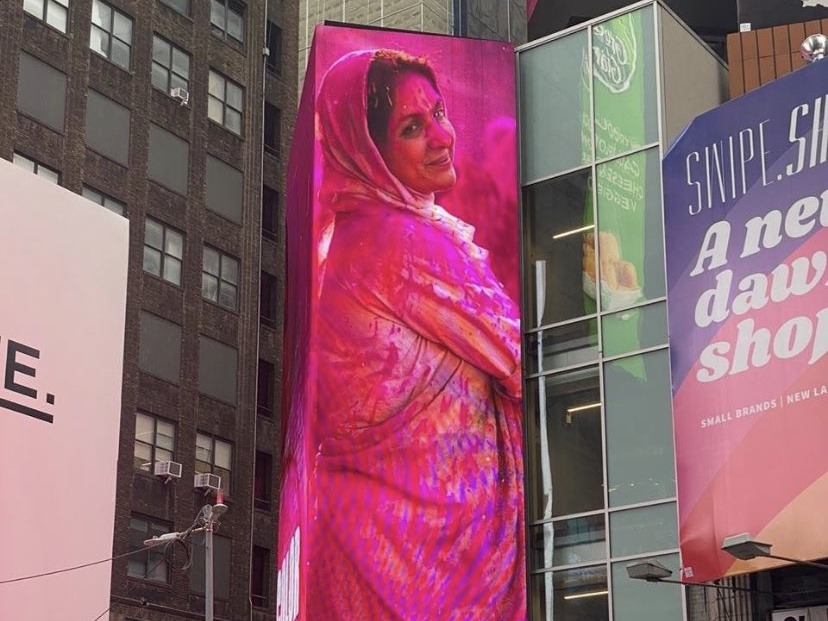Times Square in Manhattan has been splashed in a riot of pink the last few days as Michelin star Chef Vikas Khanna celebrates the opening of his directorial debut film, “The Last Color,” in India. New York City buses, too, donned colorful posters of the Neena Gupta starrer, as part of the promise the chef had made to the actress a few years ago. “I told you Neenaji, you’ll be splashing colors all over Times Square one day,” he said on his Facebook post, adding, “something in my heart believed in this dream and I worked 24/7 for it.”
“The Last Color” premiered at the 30th Palm Springs International Film Festival in January 2019 and has travelled the world and screened to critical acclaim everywhere. It won the Director’s Vision Award, at the 16th Indian Film Festival in Stuttgart and the Best Feature Film at Dallas International Film Festival.
Keeping promises is also central to the story of the film as are resilience, love and friendship. Shot in Benaras, the film dwells on the twin blots of Indian society, the plight of widows and the caste system, even as it depicts the struggle for survival on the streets of Benaras.
Neena Gupta plays the role of Noor, a 70-year-old widow along with Aqsa Siddiqui in the role of nine-year-old tightrope walker Chhoti. The film is based on a book of the same name written by Khanna. The title refers to the restriction of widows to wearing only color white and their prohibition from participating in Holi, the festival of colors.

A writer of numerous books, mostly related to food and cooking, Khanna has attempted to turn novelist with “The Last Color.” Hosting numerous TV shows and producing several documentaries and short films, Khanna has donned many hats. Being a philanthropist is one of the bigger hats he has been wearing, which came into special focus this year when, at the start of the pandemic, he started the Feed India initiative. Backed by Pepsi, Quaker Oats, Hyatt Regency and Global Funds for widows, it delivers food and supplies to those in need in India.
In 2001, Khanna founded Cooking for Life in New York, along with other top chefs to support social causes. Vision for Palate is his award-wining workshop developed to educate people with visual disabilities about the sense of taste, flavor and aromas. On May 14, 2012, Khanna cooked for a fundraiser hosted for President Obama at the Rubin Museum of Art in New York City. Khan is also the goodwill ambassador for Smile Foundation and supports the cause of malnutrition in India. He has pledged to raise $1 million for it.
Listing out all these acts of charity helps us understand the extent of his sensitivity and compassion towards the have nots and the oppressed. “I want to use my platform, my voice to create art and empathy … Through storytelling you can create empathy in people.,’’ he says of “The Last Color.” He wrote the story after witnessing the celebration of Holi in Vrindavan, home to a sizable number of widows. Following a 2012 passage of a law by the Supreme Court of India for the rehabilitation of widows, widows for the first time played Holi, he told Outlook India.
He said it was such an emotional moment for him that he ended up calling many of his friends who did not think of it as a big deal. But, for Khanna, color had become a symbol of equality. “It became a symbol of rebirth, of empowerment.”
Outlook further reports that Khanna, who grew up in Amritsar, Punjab, had seen the discrimination of widows first hand in his family and in his neighborhood. It was an accepted norm for widows not to attend weddings, play Holi or touch a newborn. The inspiration for the film was his favorite neighborhood aunt who was not allowed to be part of any festival. “We accept this prejudice because it is everywhere.”
Indeed, color never seemed so powerful before. His social media posts express his elation at the billboard advertising. “A new milestone for independent filmmakers. Times Square never looked so beautiful and festive…. Everrrrr.”
Alpana Varma worked as a Research Assistant at the Delhi University and then as a journalist for over 10 years for several leading Indian national dailies. After leaving India for Europe, she has been working as a teacher, translator and freelance writer and editor. She lived in Mexico briefly where she worked in intercultural communications. Currently she is based in Miami.



